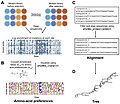Functional genomics
Functional genomics is a field of genomics that aims to understand the complex relationship between genotype and phenotype on a global (genome-wide) scale. This is achieved by employing high-throughput techniques to measure the expression of genes and their interactions.
Overview[edit]
Functional genomics uses a wide range of experimental and computational methods. These include microarray technology, next-generation sequencing, proteomics, metabolomics, and bioinformatics. These techniques allow researchers to measure the expression of many genes at once, to identify gene networks and pathways, and to observe changes in gene expression and regulation in response to genetic and environmental changes.
Techniques[edit]
Microarray technology[edit]
Microarray technology is a powerful tool used in functional genomics to study gene expression on a genome-wide scale. It allows researchers to measure the expression levels of thousands of genes simultaneously.
Next-generation sequencing[edit]
Next-generation sequencing (NGS) is another important tool in functional genomics. NGS technologies can sequence DNA and RNA much more quickly and cheaply than the previously used Sanger sequencing.
Proteomics[edit]
Proteomics is the large-scale study of proteins, particularly their structures and functions. It is an important component of functional genomics as proteins are the functional units of the cell and changes in their expression can reflect changes in gene function.
Metabolomics[edit]
Metabolomics is the study of the unique chemical fingerprints that specific cellular processes leave behind. It is a relatively new field and is considered the "final frontier" of molecular biology.
Bioinformatics[edit]
Bioinformatics is an interdisciplinary field that develops methods and software tools for understanding biological data. In functional genomics, bioinformatics tools are used to analyze and interpret the vast amounts of data produced.
Applications[edit]
Functional genomics has many applications in various fields such as medicine, agriculture, and biology. It can be used to identify disease genes and drug targets, to improve crop varieties, and to understand basic biological processes.
See also[edit]
Ad. Transform your life with W8MD's Budget GLP-1 injections from $75


W8MD offers a medical weight loss program to lose weight in Philadelphia. Our physician-supervised medical weight loss provides:
- Weight loss injections in NYC (generic and brand names):
- Zepbound / Mounjaro, Wegovy / Ozempic, Saxenda
- Most insurances accepted or discounted self-pay rates. We will obtain insurance prior authorizations if needed.
- Generic GLP1 weight loss injections from $75 for the starting dose.
- Also offer prescription weight loss medications including Phentermine, Qsymia, Diethylpropion, Contrave etc.
NYC weight loss doctor appointmentsNYC weight loss doctor appointments
Start your NYC weight loss journey today at our NYC medical weight loss and Philadelphia medical weight loss clinics.
- Call 718-946-5500 to lose weight in NYC or for medical weight loss in Philadelphia 215-676-2334.
- Tags:NYC medical weight loss, Philadelphia lose weight Zepbound NYC, Budget GLP1 weight loss injections, Wegovy Philadelphia, Wegovy NYC, Philadelphia medical weight loss, Brookly weight loss and Wegovy NYC
|
WikiMD's Wellness Encyclopedia |
| Let Food Be Thy Medicine Medicine Thy Food - Hippocrates |
Medical Disclaimer: WikiMD is not a substitute for professional medical advice. The information on WikiMD is provided as an information resource only, may be incorrect, outdated or misleading, and is not to be used or relied on for any diagnostic or treatment purposes. Please consult your health care provider before making any healthcare decisions or for guidance about a specific medical condition. WikiMD expressly disclaims responsibility, and shall have no liability, for any damages, loss, injury, or liability whatsoever suffered as a result of your reliance on the information contained in this site. By visiting this site you agree to the foregoing terms and conditions, which may from time to time be changed or supplemented by WikiMD. If you do not agree to the foregoing terms and conditions, you should not enter or use this site. See full disclaimer.
Credits:Most images are courtesy of Wikimedia commons, and templates, categories Wikipedia, licensed under CC BY SA or similar.
Translate this page: - East Asian
中文,
日本,
한국어,
South Asian
हिन्दी,
தமிழ்,
తెలుగు,
Urdu,
ಕನ್ನಡ,
Southeast Asian
Indonesian,
Vietnamese,
Thai,
မြန်မာဘာသာ,
বাংলা
European
español,
Deutsch,
français,
Greek,
português do Brasil,
polski,
română,
русский,
Nederlands,
norsk,
svenska,
suomi,
Italian
Middle Eastern & African
عربى,
Turkish,
Persian,
Hebrew,
Afrikaans,
isiZulu,
Kiswahili,
Other
Bulgarian,
Hungarian,
Czech,
Swedish,
മലയാളം,
मराठी,
ਪੰਜਾਬੀ,
ગુજરાતી,
Portuguese,
Ukrainian







